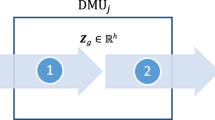Abstract
Data envelopment analysis (DEA) is a methodology used to measure the relative efficiencies of peer decision-making units (DMUs). In the original model, it is assumed that in a multiple input, multiple output setting, all members of the input bundle affect the entire output bundle. There are many situations, however, where this assumption does not hold. In a manufacturing setting, for example, packaging resources (inputs) only influence the production of those products that require packaging. This is referred as partial input-to-output interactions where the DEA model is based on the view of a DMU as a business unit consisting of a set of independent subunits, such that efficiency of the DMU can be defined as a weighted average of the efficiencies of those subunits. The current paper presents an extension to that methodology to allow for efficiency measurement in situations where there exist multiple procedures or processes for generating given output bundles. The proposed model is then applied to the problem of evaluating the efficiencies of a set of steel fabrication plants.

Similar content being viewed by others
Explore related subjects
Discover the latest articles and news from researchers in related subjects, suggested using machine learning.References
Barnum, D., & Gleason, J. (2010). DEA efficiency analysis involving multiple production processes. Applied Economics Letters, 17, 627–632.
Charnes, A., & Cooper, W. W. (1962). Programming with linear fractional functionals. Naval Research Logistics Quarterly, 9, 181–185.
Charnes, A., Cooper, W. W., & Rhodes, E. (1978). Measuring the efficiency of decision making units. European Journal of Operational Research, 2(6), 429–444.
Cook, W. D., & Zhu, J. (2006). Incorporating multiprocess performance standards into the DEA framework. Operations Research, 54(4), 656–665.
Cooper, W. W., Park, K. S., & Yu, G. (1999). IDEA and AR-IDEA: Models for dealing with imprecise data in DEA. Management Science, 45, 597–607.
Duenas, A., & Petrovic, D. (2008). An approach to predictive-reactive scheduling of parallel machines subject to disruptions. Annals of Operations Research, 159(1), 65–82.
Fang, L., & Zhang, C.-Q. (2008). Resource allocation based on the DEA model. Journal of the Operational Research Society, 59, 1136–1141.
Färe, R., & Grosskopf, S. (1996). Productivity and intermediate products: A frontier approach. Economics Letters, 50, 65–70.
Imanirad, R., Cook, W. D., & Zhu, J. (2013). Partial input to output impacts in DEA: Production considerations and resource sharing among business sub-units. Naval Research Logistics, 60(3), 190–207.
Leung, J. Y.-T., Li, H., & Pinedo, M. (2008). Scheduling orders on either dedicated or flexible machines in parallel to minimize total weighted completion time. Annals of Operations Research, 159(1), 107–123.
Lozano, S., & Villa, G. (2004). Centralized resource allocation using data envelopment analysis. Journal of Productivity Analysis, 22, 143–161.
Lozano, S., & Villa, G. (2005). Centralized DEA models with the possibility of downsizing. Journal of the Operational Research Society, 56, 357–364.
Lozano, S., Villa, G., & Adenso-Diaz, B. (2004). Centralised target setting for regional recycling operations using DEA. Omega, 32, 101–105.
Acknowledgments
The authors wish to acknowledge the helpful comments by two anonymous referees as well as those comments by the editor. Joe Zhu thanks the Priority Academic Program Development of the Jianhsu Higher Education Institutions (China) for their support of this research.
Author information
Authors and Affiliations
Corresponding author
Rights and permissions
About this article
Cite this article
Li, W.H., Liang, L., Avilés-Sacoto, S.V. et al. Modeling efficiency in the presence of multiple partial input to output processes. Ann Oper Res 250, 235–248 (2017). https://doi.org/10.1007/s10479-015-2006-2
Published:
Issue Date:
DOI: https://doi.org/10.1007/s10479-015-2006-2




